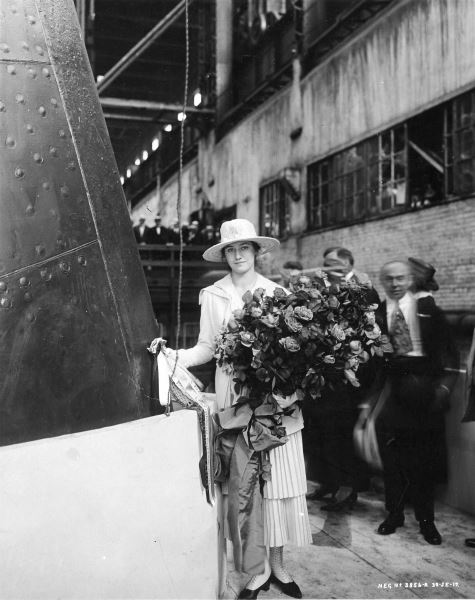
On March 4, we celebrate Idaho Day, marking the 157th anniversary of the creation of Idaho Territory by President Abraham Lincoln on March 4, 1863. This year also marks another truly grand historical event, the 100th anniversary of the passage of the 19th Amendment to the Constitution of the United States giving women the right to vote. We now celebrate that historic event and honor the women of Idaho through the 2020 Idaho Day theme, “Inspiring Idaho Women.”
It was a proud moment for Idaho to become the 4th state in the Union to grant women's suffrage in 1896, after Wyoming, Utah and Colorado.
While conducting research in the archives of the Idaho State Historical Society and the Museum of Idaho, I was inspired by the many beautiful historic photographs of women in white. During the late 19th and early 20th centuries, it was high fashion for women to wear white dresses at formal gatherings, such as graduation ceremonies, important community events, or even at parades. White projected a noble image representing purity and virtue. Women during the suffrage movement often wore white from head to toe, to emphasize the virtue of their cause and as a visual reminder of their femininity and unwillingness to appear intimidating or masculine in their crusade to win the vote.
Viewing those elegant vintage photographs provides a vivid contrast to the casual informality of our own day and seem to descend upon us as from a dream “all bathed in liquid light.” Those wistful images of Idaho women in white include a group of some 30 women campaigning for justice on a float drawn by four white horses, while another features seven dignified women in Mrs. Grover’s Bible study class in about 1900. We also see Boise women representing the Grand Army of the Republic, dedicating a statue of Abraham Lincoln in 1915, and Miss Henrietta Amelia Simon christening the battleship Idaho in 1917.
Photos in the archives featuring prominent Idaho women in period white attire include Emma Edwards Green, designer of the Idaho State Seal; Mary L. Scott, the first Idaho woman elected to state-wide office as superintendent of Public Instruction and Mary McConnell, daughter of Idaho Governor William J. McConnell and future wife of Idaho Senator William E. Borah. American Indians from Idaho wearing beautiful beaded white deerskin regalia are also to be found.
For me, the most exciting and inspirational discovery in the Museum of Idaho archives was an early 1900’s era photograph of iconic Idaho Falls educator Ethel A. Boyes. In this image she was about 18 years of age, the same year she received her teaching certificate. The photo pictures Ethel in floor length white with her hair combed up. Her silky hair actually extended below her waist and was not cut until she was about 90 years of age, according to a 1981 Post Register article.
Ethel once taught first through eighth grade in a tiny one-room schoolhouse at Carmen Creek, near Salmon. Each morning she was required to light a fire in a potbellied stove (the schools’ only source of heat). Visits to her hometown in Idaho Falls were made by stagecoach. Ethel taught and served as a principal in Idaho Falls for 39 years, mostly at Emerson grade school on 5th street, retiring in 1951. The elementary school on Brentwood Avenue was named after her in 1965.
I got to know Ethel Boyes while attending the first grade in the small historic Emerson West building in 1946. Mrs. Cobley was my regular teacher, but both she and Ms. Boyes held joint activities from time to time. I clearly remember the old wooden floors squeaking as we entered her room. Mrs. Boyes was a strict disciplinarian but captivated her students with effective teaching strategies.
Every day she drove to school in a 1927 Chevrolet sedan which she owned well into the 1960s.I remember one day she allowed me to inspect the car in the garage of her home on 19th Street. Former students usually visited Ms. Boyes at Christmas and made sure she got a birthday cake every year until she died at age 95.
Photos in the archives also featured prominent Idaho Falls women Sara Crow and Minnie Gibson Hitt. Sara is thought to have owned the first piano and taught the first music lessons during the 1880s in the village of Eagle Rock, which of course became the city of Idaho Falls in 1891. Minnie Hitt became the first woman bank manager in Idaho Falls. In 1890, she began work in her teens at the Anderson brothers General Store and Bank and ended her career in 1946 as manager of the First Security Bank of Idaho.
Minnie was a good judge of human character and often made loans without collateral of any kind, sometimes lending her own money. She could tell from a man’s hands if he worked hard. Although not a Latter-Day Saint, Minnie often helped finance missions for young LDS church members.
Many of the photographs located in the museum archives will be used by the Bonneville County Heritage Association to create a beautiful film, “Idaho Women in White.” The film will be featured in this year’s free Idaho Day celebration to be held at the Colonial Theater on March 4 at 7 p.m. It will be a fitting tribute to the women of the state of Idaho.
If you would like to read more of our March issue click here!